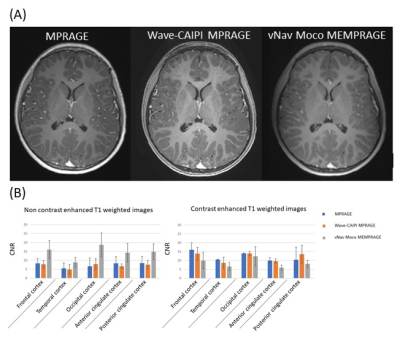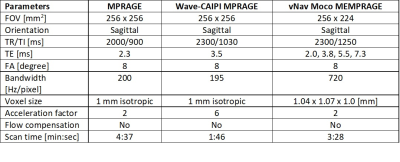Emi Niisato1, Yung-Chieh Chen2, Bhat Himanshu3, Wei Liu4, Daniel Nicolas Splitthoff5, and Cheng-Yu Chen2
1Siemens Healthcare Limited, Taiwan, Taipei, Taiwan, 2Taipei Medical University Hospital, Taipei, Taiwan, 3Siemens Medical Solutions, Malvern, PA, USA, Malvern, PA, United States, 4Siemens Shenzhen Magnetic Resonance Ltd., Shenzhen, China, Shenzhen, China, 5Siemens Healthcare GmbH, Erlangen, Germany, Erlangen, Germany
1Siemens Healthcare Limited, Taiwan, Taipei, Taiwan, 2Taipei Medical University Hospital, Taipei, Taiwan, 3Siemens Medical Solutions, Malvern, PA, USA, Malvern, PA, United States, 4Siemens Shenzhen Magnetic Resonance Ltd., Shenzhen, China, Shenzhen, China, 5Siemens Healthcare GmbH, Erlangen, Germany, Erlangen, Germany
Prospective motion correction with EPI volumetric navigators multi-echo MPRAGE
suppressed the pediatrics’ head motion artifacts compared with using fast scan and
the conventional MPRAGE. CNR of the cerebral brain showed no significant difference
among all three different MPRAGE images.

Figure 2. (A) Representative images from MPRPAGE, wave-CAIPI MPRAGE, and
vNav Moco MEMPRAGE sequences from the same patient. The patient was injected
with contrast enhancement for the scan.
(B) Contrast-to-noise ratio (CNR) for five different cortical areas. The
left figure is from the cohort that did not receive any contract enhancement,
and the right figure is from the cohort that did. The analysis was performed using
the three different sequences.
